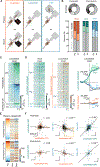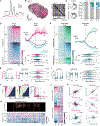Vocalization modulates the mouse auditory cortex even in the absence of hearing
- PMID: 39116205
- PMCID: PMC11720499
- DOI: 10.1016/j.celrep.2024.114611
Vocalization modulates the mouse auditory cortex even in the absence of hearing
Abstract
Vocal communication depends on distinguishing self-generated vocalizations from other sounds. Vocal motor corollary discharge (CD) signals are thought to support this ability by adaptively suppressing auditory cortical responses to auditory feedback. One challenge is that vocalizations, especially those produced during courtship and other social interactions, are accompanied by other movements and are emitted during a state of heightened arousal, factors that could potentially modulate auditory cortical activity. Here, we monitor auditory cortical activity, ultrasonic vocalizations (USVs), and other non-vocal courtship behaviors in a head-fixed male mouse while he interacts with a female mouse. This approach reveals a vocalization-specific signature in the auditory cortex that suppresses the activity of USV playback-excited neurons, emerges before vocal onset, and scales with USV band power. Notably, this vocal modulatory signature is also present in the auditory cortex of congenitally deaf mice, revealing an adaptive vocal CD signal that manifests independently of auditory feedback or auditory experience.
Keywords: CP: Neuroscience; auditory cortex; corollary discharge; courtship behavior; deafness; multimodal processing; vocalization.
Copyright © 2024 The Author(s). Published by Elsevier Inc. All rights reserved.
Conflict of interest statement
Declaration of interests The authors declare no competing interests.
Figures





References
Publication types
MeSH terms
Grants and funding
LinkOut - more resources
Full Text Sources
Molecular Biology Databases
Miscellaneous

